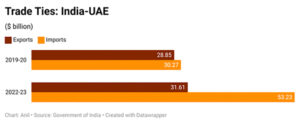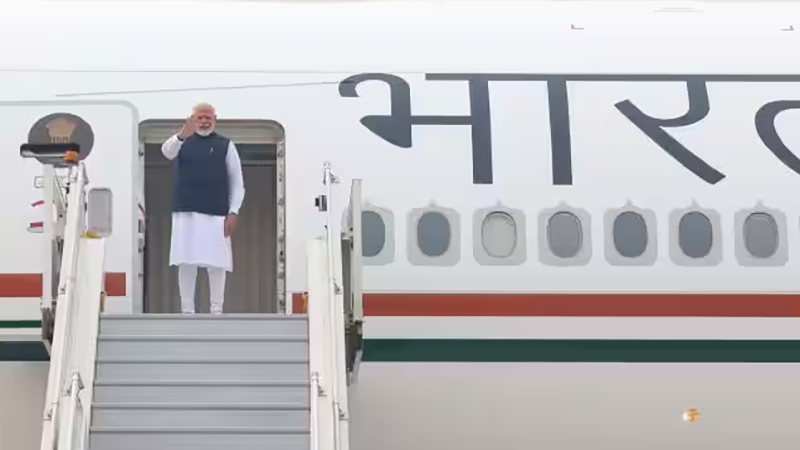Salaam India!
A day after India’s Independence Day in 2015, Prime Minister Narendra Modi touched down in Abu Dhabi for an official visit. It was the first by an Indian Prime Minister in 34 years. The last PM to visit the United Arab Emirates was Indira Gandhi in May 1981. Later today, PM Modi will return to Abu Dhabi for his seventh visit in his decade at the helm.
This period has witnessed a dramatic makeover of the relationship between the two countries, especially with the inking of the Comprehensive Economic Partnership Agreement (CEPA) in 2022 and the multi-country India-Middle-East-Europe Economic Corridor (IMEEC) last September on the side-lines of the G20 summit meeting in New Delhi.
Clearly, UAE as a reliable partner is becoming the point of entry for India into the Middle East—a region that is crucial for the country’s energy security and yet previously was never a diplomatic priority—and beyond into Europe.
The disruption of trade along the Red Sea corridor following terror attacks by Houthis based in Yemen has only reinforced the importance of the Middle East in general and the UAE in particular for India’s trade and energy security.
On Tuesday, the leaders of the two countries, Sheikh Mohamed bin Zayed Al Nahyan, and PM Modi will renew their personal chemistry to deepen the strategic and economic ties between the two countries.
Trade Ties
Historically, the two countries have enjoyed trade ties dating back centuries. In fact, at one time the India rupee used to be the currency for trade and transactions in the UAE.
The potential of this relationship got a huge boost with the signing of CEPA. At its core, the deal commits to enhancing bilateral trade between India and the UAE. With a combined GDP of over $4 trillion, the two countries represent significant markets for each other’s goods and services.
The blueprint envisages a progressive reduction in trade barriers, streamlining of customs procedures, and promoting greater market access to facilitate smoother trade. Evidence suggests that this seems to be working.

At present, the UAE has emerged as India’s second largest trading partner. It moved up a rank after the CEPA deal was clinched.
Trade data sourced from the union commerce ministry in India reveals a significant jump, despite the challenges of the covid-19 pandemic and the downswing in the global economy. The two countries withstood these shocks and are in fact, among the few growth centers in the world.
Since covid-19 disrupted the world between 2020-22, one has compared the pre-covid year, 2019-20 and the first year after CEPA. The growth in trade is dramatic. It grew by a staggering 43.6%.
This trend has sustained with trade between the two countries in the first eight months of 2023-24 ended November estimated at $48.60 billion—compared to $59.12 billion for the full year in 2019-20.
Another key element of the CEPA is to allow for greater mobility of people. UAE is home for 3.5 million Indian expats and CEPA acknowledges the importance of human capital in driving economic growth. Consequently, CEPA is easing visa procedures, promoting labour mobility, and facilitating exchange of skilled professionals.
It has also become a major destination for High Networth Indians relocating abroad. According to Henley & Partners, 55,000 dollar-millionaires have exited India. A large chunk of them have chosen to relocate to Dubai.
The growing economic connectivity and the people-to-people contact is making it easier for the two countries to layer financial connectivity on top. Accordingly, India’s home grown inter-operable payments system, Unified Payments Interface (UPI), is now available in the UAE.
NPCI International Payments Limited, a subsidiary owned by National Payments Corporation of India, signed a deal with Mashreq Bank in UAE to enable UPI transactions.
The scale of this initiative is transformative. After having integrated the respective financial networks, the central banks of the two countries are exploring trade in local currencies.
Among other things, CEPA also lays the groundwork for cooperation in emerging technologies such as artificial intelligence, blockchain, and digital innovation. It seeks a convergence between India’s expertise in technology and the UAE’s ambition to become a global hub for innovation, creating new opportunities for growth and diversification.
New Trade Dynamics
On the side-lines of the summit meeting of the G20 group of countries in New Delhi: India, Saudi Arabia, United Arab Emirates, Jordan, Israel, Italy, France and the European Union inked an agreement with the blessings of the United States to set up an economic corridor connecting India with Europe through the Middle East.
West bound trade from India will depart from either Gujarat or Maharashtra by sea and make land fall in Jebel Ali port in the UAE. From there goods will be transported by freight train to Israel through Jordan. Thereafter they will be transported by ship to Europe. Each partner country is a stakeholder and hence invested in servicing and protecting the supply chain. The IMEEC promised to be unlike anything the world had seen previously.
However, the Israel-Hamas conflict proved to be a dampener. Nonetheless, the disruption in the trade corridor connecting Europe to Asia through the Red Sea has given a boost to the idea of IMEEC. It is an idea whose time will come.
Pulling all these strands together it is clear that the deepening economic relations between the UAE and India is providing the perfect platform for the two countries to deepen their ties. Together they also hold the potential to reshape the economic landscape of the region.


Leave a Reply